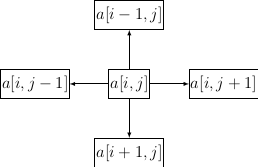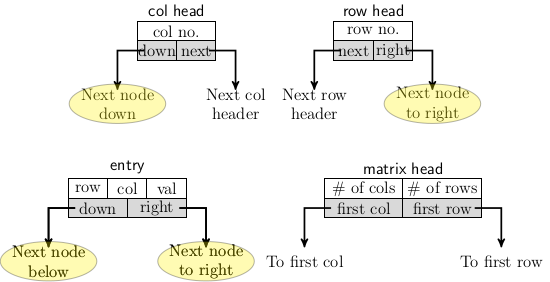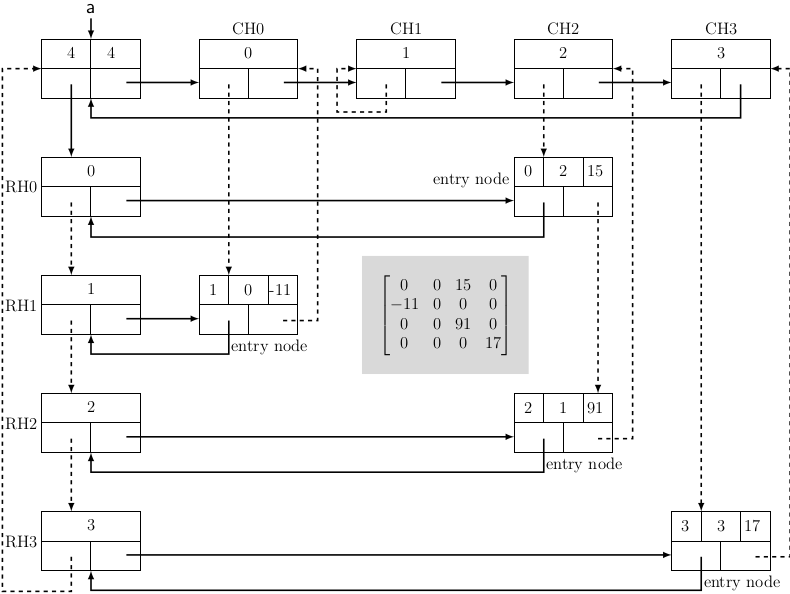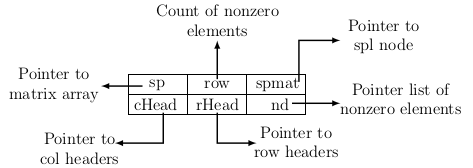Sparse Matrix
A sparse matrix of dimension mxn consists of fewer than mn/2 non-zero elements. That is, it has more zero than non-zero elements. When operating with multiple sparse matrices of high dimensionality,
storing and operating on them become challenging. The major problem lies in storing the sparse matrices. We
require a bit of careful organization taking advantage of the fact that it has many zero elements. While
investigating linked lists, we noticed that in these data structures, each element could store references
sequentially next element in the list. We can also use multiple link pointers to associate each node with a linked list
to different sequential lists. Examining the structure and operations on matrices, one may
realize that each matrix entry can be associated with four other entries to the left, right, top, and
bottom. Therefore, we use linked lists to store a sparse matrix. The figure below depicts the relation of
an entry with other neighboring entries in a sparse matrix.

The picture indicates that we can create a node structure that lets each entry of a sparse matrix be a part of at least two linked lists:
- a linked list of entries in a single column
- a linked list of entries in a single row
So, the structure of each node for matrix entries shall have two link pointers. Since non-zero elements are distributed over different matrix positions, we should store the row and column positions along with their values. The zero elements are not stored physically. So, the node structure of a matrix entry has five fields:
- The value of the entry, row, and column number to which the entry belongs.
- The pointers to the next entry are in the same row and the next in the same column.
We need header nodes to access a row or a column of the matrix. The header node of a column allows us to access the first non-zero entry in that column. A similar header node for a row is also needed to access rows and the first element of each row.
We also need a header node for the entire matrix. It should be able to point to the first column and the first row headers. So, the four different node structures we have defined are the figure below gives a pictorial illustration of the four node structures:

Figure 1
Figure 2 shows an example of storing a sparse matrix with the nodes structures we have explained above.

Figure 2
We use a unified node structure for the code to understand the organization of matrix nodes corresponding to a sparse matrix. The structure of this node is explained in the diagram below.

Figure 3
Now let us convert each node structure to a corresponding C-structure. The dimensions of the matrix are denoted by constants MAX1 and MAX2. As we have already explained, an entry node has two pointers and a triplet that defines the non-zero element’s row_no, col_no, and the value. So, the C-structure corresponding to an entry node is as follows:
#define MAX1 4 // row dimension
#define MAX2 4 // column dimension
// Structure to store a non-zero element
typedef struct Node {
int row; // row number
int col; // col number
int val; // Value of the entry
struct Node* right; // Ptr to next element in the same row
struct Node* down; // Ptr to next element in the same col
} ENTRY;
The next two C-structures are for column and row headers. Each structure has one piece of information (row or col) and two pointers. The column header should store the column number and point to the next header node and the next element in the same column. Similarly, a row header stores the row number and pointers to the next element in the same row and the next row header. For uniformity the next header nodes are accessible from next pointers in corresponding header nodes. The next element in the same row occurs to the right and is accessible from the right pointer of an entry node. The next element in the same column occurs below the current entry node. So it is accessible from the down pointer. The first element in a column and the first element in a row are accessible from corresponding header nodes by right and down pointers from respective headers.
// Structure for column headnode
typedef struct cHead {
int colno;
ENTRY * down;
struct cHead* next;
} CHAD;
// Structure for row headnode
typedef struct read {
int rowno;
ENTRY * right;
struct rHead* next;
} RHEAD;
Since we are using linked lists to implement a sparse matrix, we need a node that allows us to access all the sparse matrix, including headers and entries. So, we create a spmat node. It should have pointers to the first row and the first column and store information regarding the number of rows and columns in the matrix. A C-structure to implement it is given below.
// Structure for matrix headnode
typedef struct spmat {
RHEAD * firstRow;
CHEAD * firstCol;
int nRows;
int nCols;
} SPMAT;
Finally, we must create the triplets for non-zero elements from a user’s input to experiment with our implementation. A composite structure for sparse matrix creation and subsequent operations is defined below.
// Use for accessing whole of sparse matrix including
// all elements which allows us to also build triplets
typedef struct sparse {
int* sp; // Storage for all elements
int row; // Number of non-zero elements in matrix
SPORT * smat;
CHEAD * cHead[MAX2];
RHEAD * rhead[MAX1];
ENTRY * and;
} SPARSE;
Each non-zero element is a triplet of the form (row_no, col_no, value). Let nonZero be the number of non-zero elements, and mn is the dimension of the matrix. Then the ratio of mn-nonZero and mn defines the sparsity of the matrix. If sparsity exceeds 0.5, then the matrix is sparse. The sparse matrix is shown in Figure 3 has only four non-zero elements. Therefore the sparsity of the matrix = 0.75.
We can create a sparse matrix by creating an entry node for each non-zero element. The entry node is placed in the position corresponding to its row and column number. The code for creating the entry node is given below.
// Create an array MAX1 x Max2 for matrix
void createArray(SPARSE * p) {
int n, i;
p->sp = (int*)malloc(MAX1 * MAX2 * sizeof(int));
// Read values and store in array
for (i = 0; i < MAX1 * MAX2; i++) {
printf("Enter element no. %d:", i);
scanf("%d", &n);
*(p->sp + i) = n;
}
}
The entire source code for creating, inserting, and printing non-zero elements of a sparse matrix is available from the link below. We have not examined matrix operations. There are many algorithms for operations on sparse matrix. These algorithms do not come under the scope of data structures.